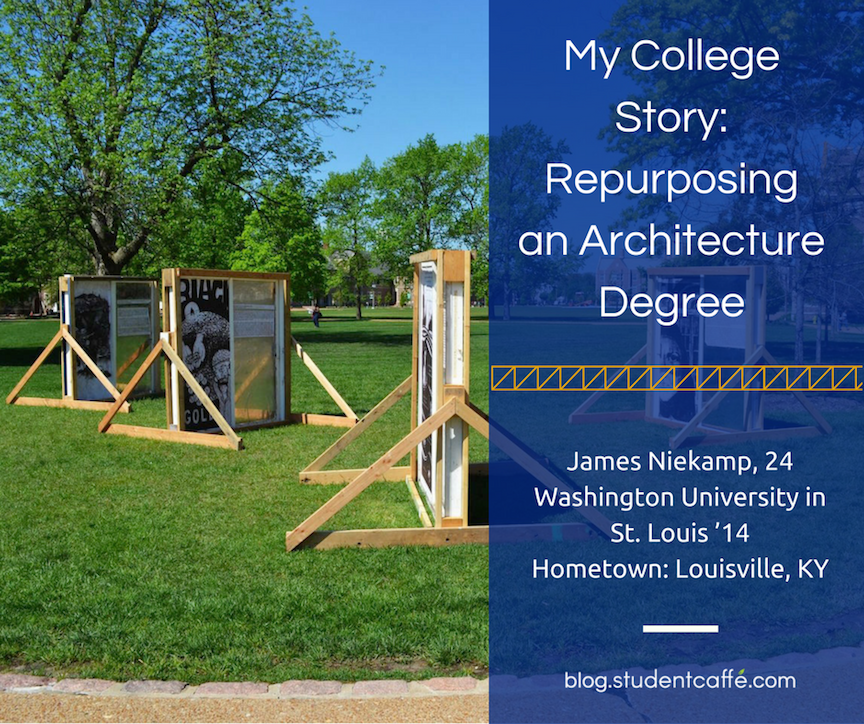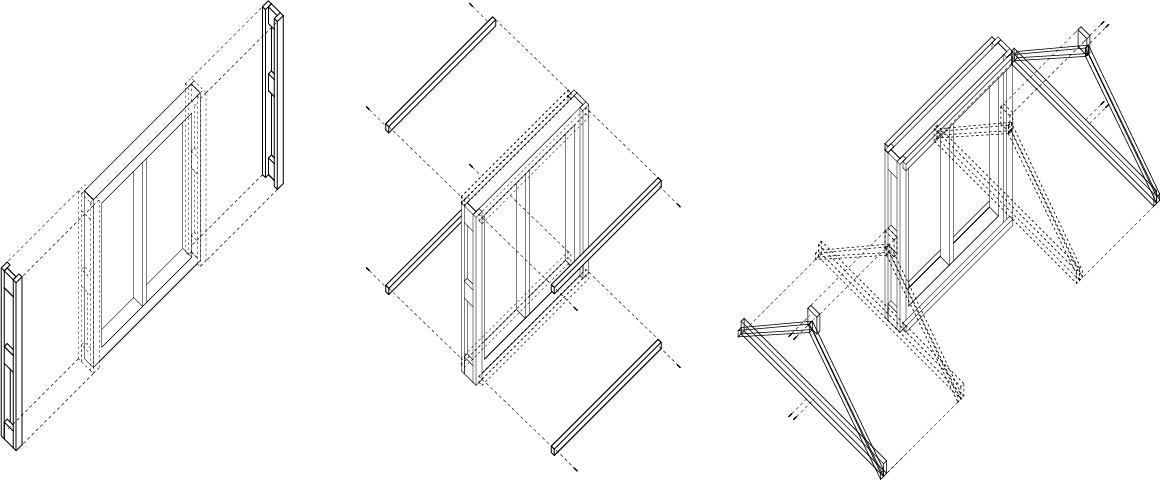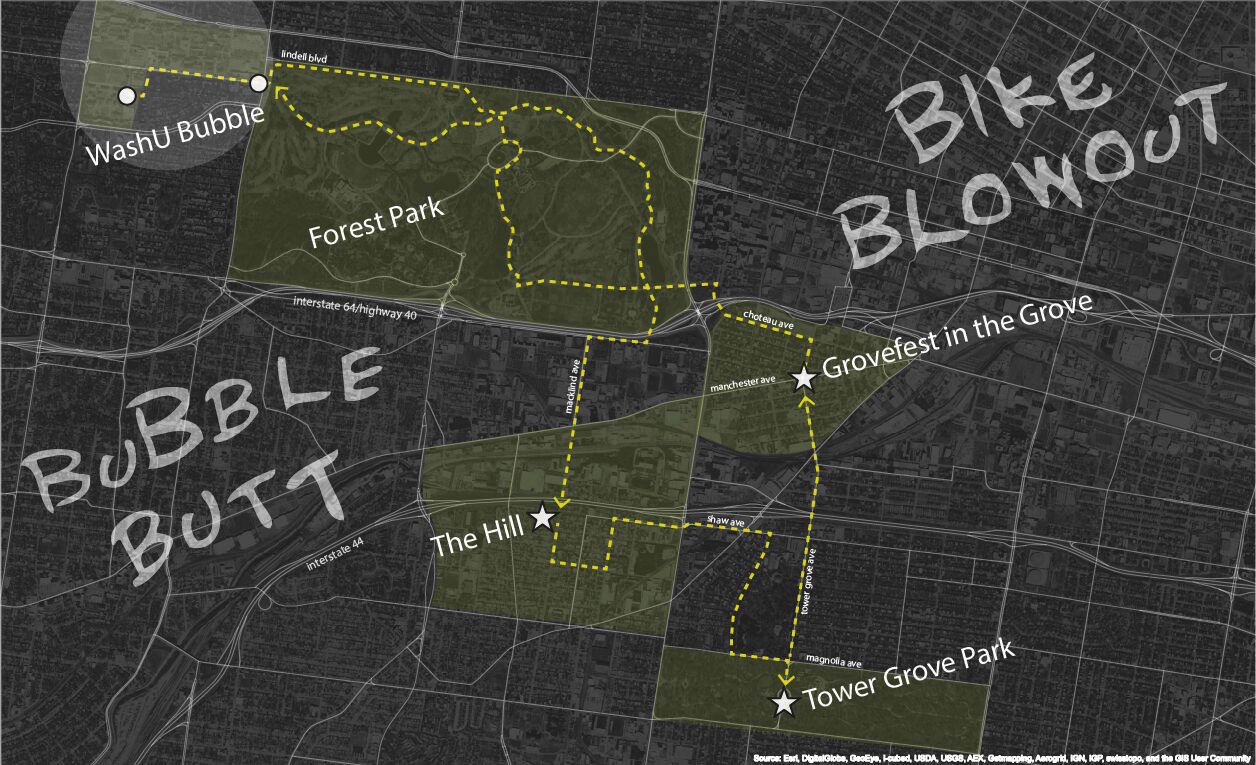
James Niekamp
Many people realize that the career path they dreamed about in high school no longer suits their aspirations for the future; James Niekamp is one of them. At a young age, he decided he wanted to become an architect, and he developed the math and visual art skills necessary to pursue it at Washington University in St. Louis. When he was halfway through college, his involvement with an on-campus student group gave him the opportunity to utilize his design skills in alternate ways, and he realized that architecture was no longer his sole passion. He graduated with his degree in 2014, but he has used the past couple of years to better understand his career aspirations. This journey has taken him from electrical distribution design onto the Appalachian Trail and now back to school. He is currently enrolled in a program in user experience/user interface design.
Q. Why did you decide to pursue an architecture degree in college?
My path to architecture started with an interest in large cities during middle school. I remember the first time I really comprehended the massivity of New York City. I saw an image taken from the top of the Rockefeller Center overlooking Central Park, and I thought the edges of the park, where the trees meet the skyscrapers, were sublime. The scale of the city surprised me. It was so different from the small city where I grew up. This really sparked my interest in architecture. I began spending hours researching skyscrapers on the internet. However, it wasn’t until my sophomore year of high school that I decided to pursue architecture in college. It was suggested to me by some of my family members because I was talented in both math and the visual arts. It was this support that really sealed the deal for me.
Q. How would you describe the workload of the architecture program?
It was definitely overwhelming at times. As architecture students, we were asked to communicate our ideas through drawings and models. Creating these modes of representation was inherently more time consuming than typing a paper, but we were held to the same deadlines and rigorous demands as our nonarchitecture peers.

James Niekamp
Q. How did you cope with the demands?
That was definitely a challenge. I would like to say I made healthy changes in my life to deal with the stress, but that wasn’t always true. I guess it’s understandable. I don’t think any of us architecture students were truly prepared with the time management skills necessary to maintain a healthy balance. I would pull all-nighters and work on the weekends into the evening.
Q. Did you supplement your classroom learning with extracurricular activities?
Yes. I focused a lot of time into a student group called Material Monster my junior and senior years. The group was interested in the intersection of design and environmental and social justice issues.
Q. What skills and insights did you gain from partaking in Material Monster?
I was approached by the director of the group my junior year. She wanted to know if I was interested in designing the gallery space for a student art exhibition on campus. It was perfect timing. I had become disillusioned by the academic side of architecture. The projects I was working on in school seemed so distant from reality, so I jumped at the opportunity to apply my skills outside of a conceptual project.

James Niekamp
When designing the gallery space, I utilized the architecture skills I had attained in the classroom. However, my second collaboration with Material Monster was completely different. We began [the project] by identifying a campus-wide problem: too many students found themselves stuck in what was called “the WashU bubble.” We understood that there were physical and social barriers keeping students from leaving campus and becoming citizens in the greater St. Louis community. To address the issue, we decided to organize a bike adventure to teach students about bicycle infrastructure and different neighborhoods in the city. At each neighborhood, we planned to have a lecture by a key figure in the community. This project was pivotal in changing the way I saw myself as a designer. I realized that urban issues may not always be best solved with a building and that my design skills could be applied in alternative ways.
Q. After completing your second project with Material Monster and graduating from WashU, what were your career aspirations? Have they changed over the last few years?
I didn’t have a clear idea of my career aspirations when I graduated. Many of my friends were applying to architecture grad schools and to jobs in architecture firms, but neither of those options felt right to me. I didn’t know what I wanted to do. I came into architecture school with a dream of becoming an architect, but by the time I graduated, that dream was no longer dominating. My time with Material Monster really opened up my mind in that way, and so when I graduated, I was completely unsure as to what I wanted to do. My journey since graduation has really been about determining a path for myself.
Q. What has that journey looked like?
My immediate postcollege experiences were harsh. I began working as an electrical distribution designer for a large utility company. I think I knew immediately that it wasn’t what I ultimately wanted to pursue, but I took the job because for the first time ever in my life, I needed to support myself financially. I felt like I just needed to get a job. It turned out to be very technical, and I missed making aesthetic decisions. It was also a very unhealthy work environment for me, which really led to a breaking point. I decided I would spend five more months working there and then quit, put my career on hold, and take six months to focus on myself and hike the Appalachian Trail. It was an amazing experience and gave me the time and space I needed to clear my head and enjoy my life. When I returned, I was in a much better place to make a decision for how to move forward with my career.
Q. What is your favorite memory from hiking the Appalachian Trail?
It’s hard to pinpoint a favorite memory because during my six months hiking, there were many ups and downs, but as I think about it right now, my mind keeps going to a specific night that, in all honesty, wasn’t that exciting on the surface. There wasn’t a sunset on a summit of a mountain or a raging waterfall. But it was the night that [my friend] Gonzo met [my other friends] Frog and Toad for the first time. These are three of the most important people I met while hiking. Each of them truly enriched my experience on the trail in their own ways.
I met Frog and Toad in New Jersey, and we hiked into Pennsylvania together. We parted ways, however, because they needed to jump ahead on the trail to keep with their scheduled Thanksgiving finish date. It was unclear when or if I would see them again.

Megan Reynolds
Sometime in the following days, I met Gonzo, and we began hiking together. One night, we met a woman at a shelter who had done a southbound thru-hike a couple of years before. She warned us of hiking in the Smoky Mountains in December (what we were on track to do) and told us stories of zero-degree temperatures and hiking through deep snow. She said she would wake up every hour in the night shivering. Her stories ignited a slight anxiety within us because these were conditions neither of us were prepared for, and so we decided one morning that we would try to increase our daily miles.
That day we hiked close to a marathon in the rocky Pennsylvania terrain, walking well into the night with our headlamps. Our feet were in pain and had been for at least 10 miles. We couldn’t wait to get to the shelter and sleep. When we arrived, we could see headlamps inside, which turned out to be Frog and Toad’s. It was such a treat to see them again. And looking back now, it was a beautiful moment when my friends got to meet for the first time.
Q. What are you currently doing with your life?
I am just beginning an 18-week bootcamp program in user experience (UX)/user interface design.
Q. How are you adapting to being a student again?
I am enjoying it, but it isn’t easy. I am trying to learn from some of the mistakes I made in college to be better at managing my time and managing my anxiety. So far, I’ve been pretty successful, but I’m still a work in progress.
Q. How did WashU prepare you for this program?
I feel very prepared because of my time at WashU. I already have skills in a couple of the industry-standard computer programs. I have significant experience in design thinking, conceptual thinking, drawing, iteration, and critique, all of which are necessary for becoming a UX designer. I feel very lucky in that regard.
Q. What advice would you give to current college students who are anxious about life postgraduation?
Listen to yourself. Figure out what you really do like and do not like. Do this by talking to people who are already out in the world working. Ask them about their jobs. Shadow them. And don’t let fear keep you from taking a risk.
-
My College Story: Winning the Chegg Contest to Volunteer in Ecuador
-
My College Story: Student, Employee and Business Owner
-
My College Story: The Power of Motivational Majors and Self-Education
-
My College Story: From Baseball in College to Baseball on the Island
-
My College Story: Graduating After Years of Study, Transfers, and Time Off
-
My College Story: Technology and Design
-
My College Story: WWOOFing and Learning to Farm after College
-
My College Story: Ending Up Exactly Where I Need to Be
-
My College Story: Transitioning From High School to College
-
My College Story: Learning to Live with PMDD
-
My College Story: From Studying Art History to Law School
-
My College Story: From Student to Teacher

